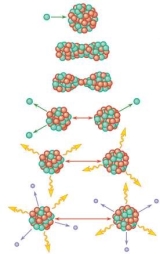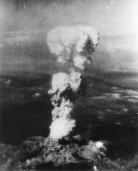What Was the Development Process of Atomic Bomb Which Lead Its Impact on World War II?
| ✅ Paper Type: Free Essay | ✅ Subject: Chemistry |
| ✅ Wordcount: 1441 words | ✅ Published: 3rd Nov 2020 |

The first-ever nuclear fission was discovered in 1938, December 17th, nine months before World War II has started. It was an accidental discovery from Nazi Germany. The finding of nuclear fission led to nuclear weapons such as the atomic bomb. Currently, there are around 13,890 nuclear weapons around the globe.
Atomic bomb is a weapon that produces great explosive power from the result of the sudden release of energy upon fission of the nucleus of an element such as uranium or plutonium. When a single free neutron is absorbed into a nucleus of the isotopes plutonium-239 or uranium-235, it causes the nucleus of an atom to break down into two smaller nuclides with similar weight and changes plutonium-240 or uranium-236 (shown in Figure 2). During the process of splitting, it creates a huge amount of thermal energy and gamma rays. It also releases an average of two to three more neutrons and under a certain requirement, neutrons that have been released strikes into other uranium nuclei in that area which releases more nucleus. Once the reaction has been started, it rapidly multiplies fissions and this process is called a chain reaction. A chain reaction that’s getting bigger is called an uncontrolled chain reaction. Once the energy has enough energy, it produces a huge explosion which is known as an atomic bomb.
Figure 2-This is a diagram of nucleus when they are fissioned by a neutron in sequence order.

Figure 3-Explosion of atomic bomb ‘Fat Man’ dropped on Nakasaki
A lot of isotope of uranium can undergo fission, however, uranium-235, which are found only 0.7% of natural uranium while uranium-238 is 97.3%, is the only natural nuclear which can undergo fission easily and release more neutron per fission. Plutonium-239 has the same aspect as uranium-235. These are mostly used for atomic bombs and fuel in a nuclear reactor. It can’t undergo a chain reaction with a tiny amount of uranium-235 because once the neutrons are released, it is likely to flow without hitting any other nucleus. As there is more uranium-235, the chance of neutron causing another fission will increase and once the critical mass has been reached, it will result as an atomic explosion.
If you need assistance with writing your essay, our professional essay writing service is here to help!
Essay Writing ServiceEnormous amount of energies are released when fissions release. Dropping 1kg of completely fissioned uranium-235 has equivalent energy of dropping 17kilotons of TNT. The explosion from the atomic bomb releases an excessive amount of thermal energy. This creates a huge mushroom-shaped cloud (figure 3) and the heat ignites the ground which can cover an entire small city. The explosion also creates a strong shock wave that can destroy buildings that are several miles away from the burst.
Radiations from the atomic bomb can also harm humans. Effects, when human bodies are exposed to the radion, are blood disorder, cataracts, malignant tumours and keloids and can lead to death.

Figure 4- Photo of Otto Hahn
On December 17th, 1938, nuclear fission has been discovered by Otto Hahn and his assistance Fritz Strassmann. Otto Hahn was a german chemist who was awarded the Nobel Prize for his discovery of nuclear fission in 1944. He founded that when neutrons are used instead of protons, greater quality of artificial radioactive nuclide could be performed. He continued to do his experiment and by end of 1928, Otto Hahn and Fritz Strassmann were able to show that atomic fissions occur when the new, lighter elements barium and others that were half the mass of uranium.
Our academic experts are ready and waiting to assist with any writing project you may have. From simple essay plans, through to full dissertations, you can guarantee we have a service perfectly matched to your needs.
View our servicesIt was also 1938 when the story of the Manhattan Project began. About a month after nuclear fission was discovered by Otto Hahn, Leo Szilard and Albert Einstein sent a to Fraklin D. Roosevelt, who was the president US, to warn that Germany might plan to build an atomic bomb. As a response, the president has formed a Uranium community where groups of top military and scientists to discover the fissibility of the nuclear fission reaction.
The Manhattan Project officially began in 1942 August 13th. It was named like that because the first office was simply located in Manhattan. By 1944, around 6000 researchers and engineers intended to work on building the first-ever nuclear weapon. A physicist named Robert Oppenheimer was the director of the Manhattan Project research, LANL (Los Almos National Laboratory), and the development facility. Due to the security reason, LANL was located in the desert in New Mexico.
Leslie Groves, army crop of Engineers officer in the US, oversaw the Manhattan project for the American government. He was appointed to head the Manhattan Project in 1942 September. As a leader, he was responsible for this project. He needed to plan the use of the bomb, the process of the development, construction, and security. Eventually, the Manhattan Project employed around 130 thousand Americans with 37 facilities spread around the country.
In May 1945, Allies defeated Germany just two months before the atomic bomb was invented but however, the war with Japan has been kept going. Harry S. Truman has the use of atomic on Japan as he wasn’t getting any reply of surrender from Japan. It was 1945 August 6th when the atomic bomb named ‘Little Boy’ has been dropped on Hiroshima, Japan. When it was exploded, everything in that city was gone. The explosion had the same force of 12,500t of TNT. Around 140,000 were killed or died due to the radiation posing during the explosion within a month. The day after the bombing, Japan still refused to surrender so on August 9th, the US dropped their second bomb named ‘Fat Man’ on Nagasaki, Japan and around 80,000 people were killed. Japan surrendered six days after and it was the end of WWII.


Figure 5- Atomic Bomb named ‘Fat Man’.
Figure 6- Atomic Bomb named ‘Little Boy’.
The atomic bomb ‘Little Boy’ (Figure 6) is enriched uranium fueled nuclear weapon. The efficiency of this weapon wasn’t as great as the ‘Fat Man’. Approximately 1.38% of the were actually fissioned. The model ‘Fat Man’ (Figure 5) is 10 times more efficient than the Little Boy. Plutonium-239 was used for this weapon.
Nuclear weapons are still being developed currently. The atomic bomb was one of the most powerful weapons in WWII and it was only used in WWII and haven’t been used since then.
References
- “24.6: Nuclear Fission Processes.” Chemistry LibreTexts, 27 June 2016, chem.libretexts.org/Bookshelves/Introductory_Chemistry/Book%3A_Introductory_Chemistry_(CK-12)/24%3A_Nuclear_Chemistry/24.6%3A_Nuclear_Fission_Processes. Accessed 6 Nov. 2019.
- “J. Robert Oppenheimer.” Atomic Heritage Foundation, 2000, www.atomicheritage.org/profile/j-robert-oppenheimer. Accessed 6 Nov. 2019.
- “Leslie R. Groves.” Atomic Heritage Foundation, 2019, www.atomicheritage.org/profile/leslie-r-groves. Accessed 6 Nov. 2019.
- “Little Boy and Fat Man.” Atomic Heritage Foundation, 2014, www.atomicheritage.org/history/little-boy-and-fat-man. Accessed 7 Nov. 2019.
- “Long Term Effects on Humans | Effects of Nuclear Weapons | Atomicarchive.Com.” Atomicarchive.Com, 2015, www.atomicarchive.com/Effects/effects16.shtml. Accessed 7 Nov. 2019.
- “Nuclear Fission and Fusion - AQA - Revision 1 - GCSE Physics (Single Science) - BBC Bitesize.” BBC Bitesize, 2019, www.bbc.co.uk/bitesize/guides/zx86y4j/revision/1. Accessed 8 Nov. 2019.
- “Radioactivity : Uranium 238 and 235.” Eu.Com, 2019, www.radioactivity.eu.com/site/pages/Uranium_238_235.htm. Accessed 6 Nov. 2019.
- The Editors of Encyclopedia Britannica. “Atomic Bomb | History, Properties, Proliferation, & Facts.” Encyclopædia Britannica, 6 Nov. 2017, www.britannica.com/technology/atomic-bomb.
- “The Manhattan Project.” Atomic Heritage Foundation, 2000, www.atomicheritage.org/history/manhattan-project. Accessed 7 Nov. 2019.
- “The Manhattan Project and the Atomic Bomb.” Khan Academy, 2008, www.khanacademy.org/humanities/us-history/rise-to-world-power/us-wwii/a/the-manhattan-project-and-the-atomic-bomb. Accessed 7 Nov. 2019.
Cite This Work
To export a reference to this article please select a referencing stye below:
Related Services
View allDMCA / Removal Request
If you are the original writer of this essay and no longer wish to have your work published on UKEssays.com then please:
 GBR
GBR 












